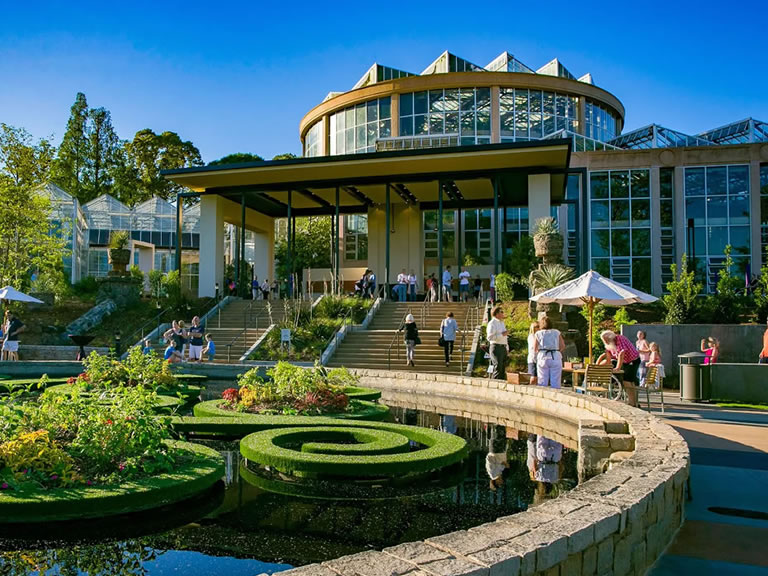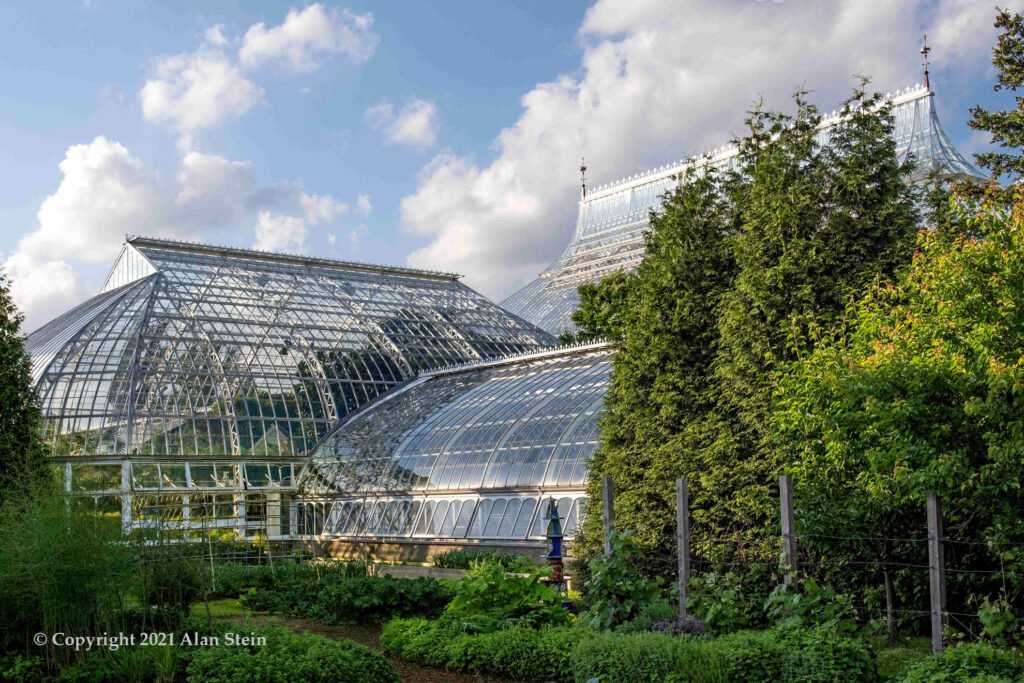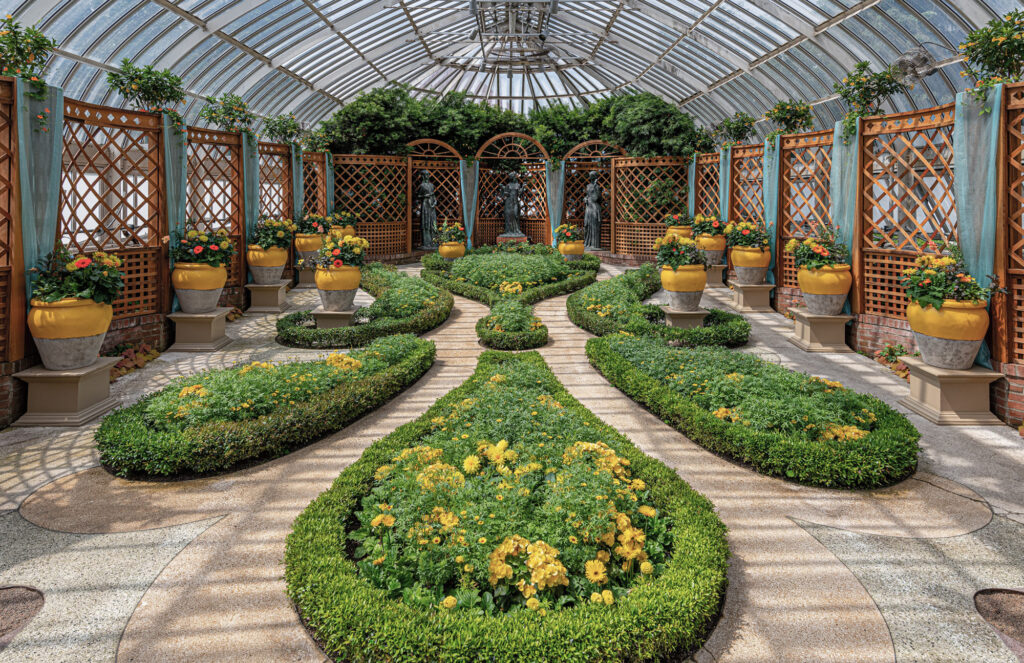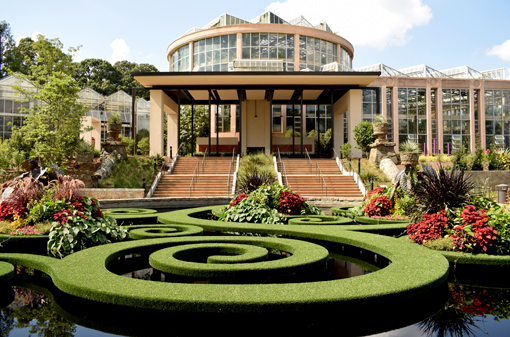From the beautiful changing of the leaves to events to fresh, new displays, Fall is one of the most fun times of the year to explore historic conservatories! Travel around the world with us in exploring some of the hidden gem conservatories you may not have heard of.
The Majorie McNeely Conservatory – St. Paul, Minnesota


Originally known as the Como Park Conservatory, it sits on about half an acre of the almost 400 acre campus of the Como Park Zoo in St. Paul, Minnesota. Designed by German-born architect Frederick Nussbaumer, Nussbaumer modeled this Victorian style glass domed conservatory after Kew Gardens in London. Completed in 1915, it is one of the few glass and wood conservatories left from that era.
The Marjorie McNeely Conservatory is about 60,000 square feet, its footprint well over an acre (43,560 sq. ft.) and anchors the gardens. You’ll find, for example, a large collection of Bonsai plants, a continuation of St. Paul’s annual fascination with the chrysanthemum plus the marvellous Palm Dome. Here over 150 varieties of palms are on display along with a color selection of orchids. For more details about this marvellous conservatory confection, click here. With every visit, this Conservatory is guaranteed to inspire you for your own conservatory. View their website to plan your visit – they always have something extraordinary going on!
Syon Park Conservatory – London, England



At Syon, the eighteenth-century conservatory is transformed into an orchestrated interplay of solid materials and light. Neither the masonry nor the glass and metal dominate the composition; rather, the glass is liberated from its former function as windows. This concept of glass and metal as a singular expressive medium in architecture prefigures the grand glass palaces of the later nineteenth century and all of the modern architecture to come.
Syon Park Conservatory, one of the most famous in the world, straddles the line separating orangery from conservatory. It marks the high point of the orangery as a building type and the beginning of the true conservatory.
Dorothy Chapman Fuqua Conservatory – Atlanta, Georgia


The Dorothy Chapman Fuqua Conservatory was opened in 1989 to highlight the botanical abundance of selected tropical and desert regions around the world. They teach the important issues of conservation and plant use through classes and fun family exhibits in hopes of spreading awareness.
Did you notice how unusual this conservatory looks compared to others we have shared? The Fuqua Conservatory is divided into four main display areas:
- Conservatory Foyer
- Orangerie
- Desert House
- Tropical Rotunda
With so many beautiful displays, it is no wonder the 16,000-square-foot Conservatory requires heat, hand-watering, ventilation and occasional organic pest control and fertilizers to maintain optimal climates for the variation in plant life. Sensors throughout the Conservatory check each minute, humidity, measuring light, and temperature, and automatic ventilation systems adjust accordingly.
For more information about their conservation and research efforts, learn more HERE. For upcoming events, exhibitions, and classes, click the button below!
Bellagio Conservatory and Botanical Gardens – Las Vegas, Nevada



The Vegas Strip seems like an unlikely location for a lovely glass conservatory… or does it??
The Bellagio Hotel Conservatory is a true oasis of calm. Referred to as a “14,000 square foot floral playground…” it lives up to its billing with changes in the flora every season. Of course, its soaring 55 ft glass ceiling perfectly sets the stage for a truly over-the-top ever-changing display. Not only that, there is no charge to wander through this earthy space.
“Seasonal display” hardly describes what the talented team of horticulturists actually produce. For example, the theme of the 2019 summer production was “Under the Sea.” It consisted of some 80,000 blooming plants, including 6,000 tulips weekly. Interspersed were colorful statues of seahorses and with a delightful collection of jelly-fish like installations hanging from the glorious glass ceiling.
If you visit Sin City, make a point to see and experience exactly how a glass conservatory can change a frenetic atmosphere into a peaceful and restorative setting – food for thought as you think about a conservatory of your own. This marvelous spot is more than worth the trip!
Flower Dome & Cloud Forest, Singapore



Two amazing conservatories, both located in Singapore’s Gardens by the Bay, offer perpetual spring in the Flower Dome and the mystery of a high mountain Cloud Forest.
Flower Dorm was listed by the 2015 Guinness World Records as the world’s largest glass greenhouse, made up of some 3,332 glass panels of 42 different shapes and sizes. With almost 3 acres under glass it comes by its record honestly. Its volume is equally startling – about as much as 75 Olympic size swimming pools.
Inside the climate is kept a balmy 73-77 degrees with humidity of about 80 percent. That precise temperature control is what allows the amazing variety of plants, from succulents to olive groves and everything in between to grow there in its various gardens – there’s even a bistro that features edible plants.
Cloud Forest is perhaps even more spectacular. The mountain inside rises to well over 100 feet and is designed to mimic an altitude of about 6,500 feet high. There is an impressive waterfall which has a viewing deck near the top.
You reach the top via a path known as the Cloud Walk. It’s built out from the mountain in an almost undulating fashion giving you a close-up view in some places, and a bit more distance in others.
The temperature and humidity are controlled to let you experience the mist so often found in a forest that high. You are, of course, surrounded by an amazing number of tropical trees and other plants.
This spectacular conservatory has 2,577 glass panels of 690 shapes! Together, Flower Dome and Cloud Forest are a conservatory experience not to be missed. They will awe and inspire you.
Phipps Conservatory – Pittsburgh, Pennsylvania


Phipps conservatory, set in “one of America’s greenest public gardens,” is located in Pittsburgh, Pennsylvania in the Oakland neighborhood. Developed in 1893, this steel and glass Victorian conservatory is found in one of the city’s biggest green spaces. This greenhouse, originally housing tropical plants from the 1893 Chicago Columbian Exposition (now known as the World’s Fair), was a gift to the city of Pittsburgh by Henry Phipps, Jr. After emigrating as a child from England to Philadelphia, this son of a cobbler became a very wealthy man after becoming Andrew Carnegie’s business partner in the Carnegie Steel Company. He was the company’s second-largest shareholder before selling his stock and deciding to devote himself to more philanthropic efforts, the first of which would be the Phipps Conservatory.
The current Conservatory consists of thirteen rooms on 2.5 acres of land, with gardens, ponds, and fountains, surrounding the outside of one of this country’s largest Victorian “crystal palaces.” The entrance pavilion of the Phipps Conservatory currently boasts a LEED silver-level certification. LEED (Leadership in Energy and Environmental Design) is a rating system started in 1998 for the “design, construction, and operation of high-performance green buildings.”
Palacio de Cristal – Madrid, Spain



The Palacio was the first non-industrial building in Spain to be constructed of iron and glass and was built in only five months. Wrought iron in the shape of angels’ faces decorates the upper ledge of the building; these decorations also serve as supports for the rain gutters. The ceramic tiles surrounding the perimeter of the building were made by Daniel Zuloaga, and are adorned with flowers, dragons and stars.
Roman Ondák, a Slovakian-born artist, is the most recent artist to have his work exhibited at the Palacio de Cristal. Ondák’s creations are notable for their grand scale and specific purposes. The scene (the name of Ondák’s creation) was constructed and designed specifically for the Palacio de Cristal. It is an elevated walkway that is accessed from the inside of the building but which encircles the outside of the building. A brochure describing the walkway notes, “this walkway… offers all its visitors the opportunity of a new perception of the space, for the Palacio de Cristal can now be looked into from the outside in a way not previously permitted by its architecture.”
The Palacio de Cristal has only needed to be restored twice. Once in 1975, when an addition at the back of the building was removed and enhancements were made which allowed the rooms to be used as exhibit halls, and then from 1994 – 1998. This restoration reinforced the metal structures, updated the security systems, and repaired some of the ceramic tiles.

